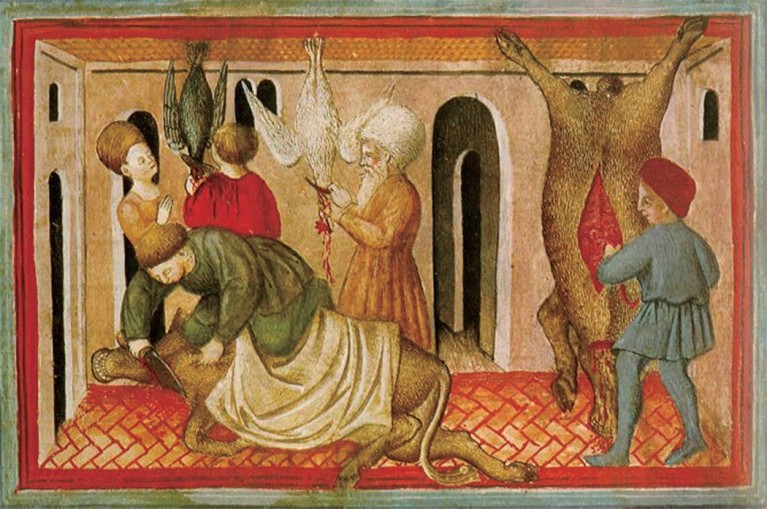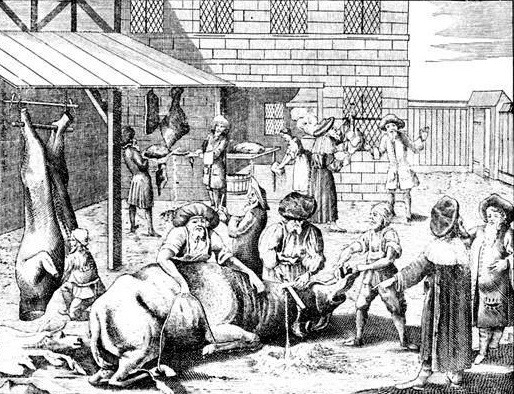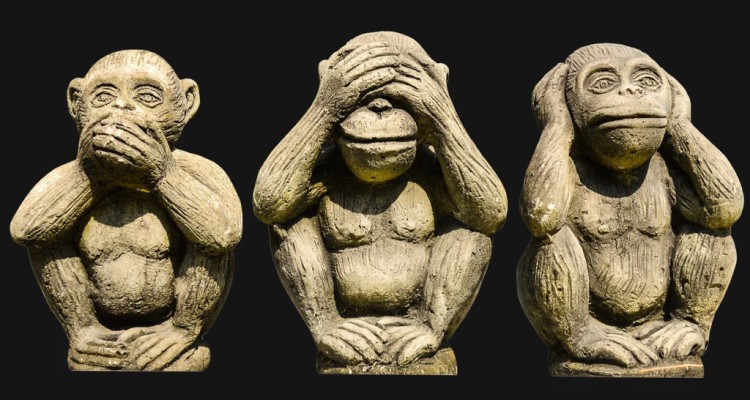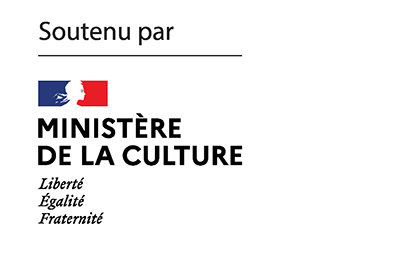A marginal or minimal problem for some, a barbaric custom that should be modernized for others, ritual slaughter is one of the pillars of Jewish life. Requiring the stunning of animals prior to killing is not contrary to the law, the European Court of Justice concluded in a recent ruling. Is ritual slaughter compatible with Europe? David Haziza asks this question in an essay published by K. in two parts.

The prohibition of shehita (שחיטה), or Jewish ritual slaughter, has been on the agenda of modern Europe for over a century. It must be seen in relation with limits on circumcision and, to a lesser extent, with a certain de facto “criminalization” – more specific to contemporary France than to other countries – of the ritual practice by which Judaism marks and shapes individual, family and collective life: the Sabbath and the holidays, the choice of a specific dress, and even of a diet that conforms to the rules of Jewish law and is displayed as such in supermarkets.
Today, it is Islam and its own slaughter techniques that abolitionists are mainly being considering. Officially, it is not a question of religion but of animal welfare (and, secondarily, of health risks). Politicians as different as Jean-Luc Mélenchon, François Fillon and Marine Le Pen share a determination to end these ancestral traditions. The Brigitte Bardot Foundation has been demanding such a ban for years.
The fact remains that animal rights concerns have been fused with discourses on European identity and secularism: it is indeed in the name of the latter that in April 2017, a Gilbert Collard, for example, justified his demand to end halal and kosher meat in France, asking his “Jewish friends” to consent to this small sacrifice, for the nation and for themselves. Alongside the question of animals, there is also the question of the place of religion in a country that believes it is free of it, or that of minority religions within a culturally Christian society.
The alarm aroused in France as in the rest of Europe by an extreme and expansive Islam might serve to abrogate Article 1 of the law instituting separating Church and State: “The Republic ensures freedom of conscience. It guarantees the free exercise of worship subject only to the restrictions enacted hereafter in the interest of public order.” This “interest”, if ritual slaughter were forbidden, would extend far beyond what the authors of this wise text could have conceived. Now, would it not be distressing if, because of a failure to deal properly with the factious and harmful elements of Islam, all Muslims were subjected to such a collective punishment – and at the same time painfully ironic if the Jews, once the first victims of Islamist intolerance in France, were also to pay for the Republic’s negligence? In contrast to what Pierre Manent advocated in the volume Situation de la France – namely, to make the disavowal of anti-Jewish hatred the basis of understanding between Muslims and other French people – the banning of ritual slaughter would marginalize Jews for good without reducing the Islamist threat.
Already the noose is tightening beyond our borders, around all those whom a new, mawkish, hygienic order now considers deviant. A 2017 decree of the Flemish Region of Belgium banned ritual slaughter without stunning; in December 2020, the Court of Justice of the European Union, which in this case had to “weigh freedom of religion, guaranteed by Article 10 of the Charter of Fundamental Rights of the European Union, against animal welfare,” confirmed the legitimacy of this decree with a ruling that stunning prior to killing did not prevent or impair ritual slaughter! For Jews, this statement amounts to a formal demand: abandon Judaism or reinvent its rules to conform to those we – the magnanimous European Union – suggest.
Through the (unacknowledged but obvious) detour of Islam, the complete banning of ritual slaughter would in fact sound the death knell of Jewish life in places where it has nevertheless managed to maintain itself, or even to revive itself – in the United Kingdom, in France, in the Netherlands, in Germany[1]. I want to show why. I am convinced that this practice is the sine qua non not only of Jewish life in Europe, but also of a European life worthy of the name.
Is Shehita Cruel?
It is not possible to answer this question without first agreeing on the meaning of words. A distinction must be made between violence and cruelty – a distinction we make less and less. I would argue that before constituting an attack on Judaism and Jews, the prohibition of shehita is the manifestation of this confusion, which is typical of our time: it makes sense in the more general search for the utopia of an education without constraint, of a language which does not offend, of an existence without risks or roughness, entirely under surveillance – of a sanitized diet. Violent, of course the shehita is! Or rather, let us say that, unlike other forms of slaughter, it does not hide the violence inherent in the act of killing an animal for food. It is not, however, cruel.
If one should not dilute the moment of the killing (cruelty), one should not hide its violence either (mawkishness). This violence is that of life itself – with which it is etymologically confused – and of the sacred, that is to say of the care ritually given to an evil that no hygienic measure would succeed in erasing. If we still believe in the sacred nowadays, it is without understanding anything about it: at the price of a monumental misunderstanding, it is seen, in the 21st century, as that which “does no harm”. We no longer know how to distinguish between the irreducible and necessary part that links violence to the sacred – and to civilization -, and the cruelty that the latter wants to negate and overcome. Shehita is perceived as torture, an exorbitant and barbaric sacrifice (in the same vein, circumcision is sometimes equated with female genital mutialtion, and described as a form of abuse, or even torture). At this level of analysis, to want to prohibit shehita is to confuse our legitimate disapproval of cruelty with a utopian abolition of violence, of danger, of punishment.
In the first place, there is a prohibition on the consumption of blood. Leviticus teaches: “For the life of all flesh is its blood, even its life; therefore I said to the Children of Israel, ‘The blood of no flesh shall you eat! Yes, the life of all flesh is its blood, and whoever eats of it will be destroyed[2]. ” Judaism has retained a notion of the animal soul which Cartesianism rejects. The nefesh is this soul, or vital impulse, life force, which the priest must let flow as quickly as possible. The slaughter (this is the meaning of the word shehita) thus consists in cutting the trachea and the esophagus in one stroke. The bleeding is coextensive with it, and it is even because the beast must be bled without delay that it is slaughtered according to the rules laid down by the Halakhah, the rabbinic law: in short, these rules make us touch, by their triviality, the essence of the Jewish faith in its timeless primitiveness
Secondly, there is the prohibition of eating a “torn animal” or “carrion”, in short, meat that is damaged, diseased or found dead. The point that draws general disapproval to the shehita is related to this prohibition: most rabbis consider that stunning an animal before slaughtering it is damaging its flesh. In addition, because some forms of stunning stop the heartbeat, bleeding can also be affected by these techniques. Therefore, the animal’s throat is slit in the “old-fashioned” way, i.e., while it is still conscious: its blood runs out immediately and its brain remains intact.
There is, however, a third principle, no less essential, no less revealed than the other two[3]: the major prohibition of causing an animal to suffer unnecessarily. This is probably the reason why, in addition to the sharpening of the knife, there are five rules which it would take too long to explain here – supposed to ensure a rapid, even instantaneous, killing[4] – which make shehita what it is, distinguishing it from other forms of ritual slaughter. It is with regard to them that Maimonides writes in the Guide for the Perplexed:
“Since there is a necessity to feed on the flesh of animals, it was intended to inflict the easiest death on them and at the same time to obtain this in the easiest way. “[5]

When shehita has been carried out under the required conditions, it is rare – contrary to what animal rights activists claim – that the agony goes on for more than several minutes: on the contrary, it has been observed that death occurs almost immediately for more than nine out of ten animals. Temple Grandin, an American professor of animal science and world-renowned expert on animal suffering, who is not Jewish and who first denounced – then rightly so – what she had observed in a kosher factory, maintains that when ritual prescriptions are carefully followed, shehita is in fact no more or less cruel than any other method of slaughter. In fact, it may be less cruel.
She noted, for example, that a cow whose throat was slit in this way did not struggle, suggesting that it was unaware that it was being killed. The modifications that Grandin proposed for this reason go “less far” than perhaps even some rabbis would admit: they do not concern the basis of the shehita but the poor conditions under which it is sometimes performed.
Let us recall in passing that the effectiveness of the methods by which ordinary slaughterhouses claim to limit animal suffering is more than questionable. The French commission of inquiry created at the request of Olivier Falorni in 2016, which looked into ritual slaughter, followed the dissemination of extremely shocking images by the L214 animal rights association: they came from conventional slaughterhouses. In truth, the conditions under which the animals are transported and even their stunning sometimes only result in a tenfold increase in their suffering: it is not so rare that pigs or cows, which we believe or pretend to believe are unconscious, are skinned, not only alive, but also well and truly conscious due to a technical error.
Finally, are the conditions of the animal’s existence not more important than its last moments? “Clean” death is illusory, perhaps even worse, and although there are certainly human limits to the killing process, I think that one or two minutes of consciousness, let alone a few seconds, does not change the intrinsic violence of death. What does change something for the animal, and it seems that no enemy of shehita cares about this, is what precedes it: the breeding, the very organization of the slaughterhouse, the life of the animals. In nature, death is much more violent than when we carry it out, but life is much sweeter and more dignified than what our industrial and intensive breeding offers them. It is not unnatural to slaughter an animal, but to make it “live” in a cage is.
Therefore, let’s say right away that if factory farming were seriously and as a priority denounced; if hunters and fishermen were asked to stun the animals they kill, which is obviously impossible; if we were to hear the “friends of animals” attacking the castration of bulls, horses or, for that matter, dogs and cats, or deploring the life of misery (made of, among other things, sexual repression) reserved for these last two species by our selfish and cowardly domestic order; if the stallion that has had its day, the dog that, probably for its own good, we prefer not to see roaming the streets, were not systematically slaughtered; finally, if it were sincere and enlightened – informed, for example, by what recognized experts say – perhaps we could take the criticism of the shehita seriously. As it is, this is not possible, and so the question remains as to the reasons, conscious or otherwise, for this criticism.
Brief History of the Ban on Shehita in Europe
Switzerland was the first European state to ban the sheḥitah. It did so by popular initiative in 1893: it was then the first time that a law was passed there in this way. Although there were very few Jews at the time, it was thought appropriate to consult the population on a difficult question, new since stunning was a recently established method, and finally relatively minor – at least in a country that was not to know any other legislation on “animal protection” until 1978, and where hunting is obviously permitted. Battery farming is forbidden, I admit, but only since 1992, sixty years after its introduction of this practice. Moreover, and this is not well known, in some remote areas of the Swiss countryside, it is permitted to eat dog meat privately, i.e. without any surveillance: is it not difficult, under these conditions, to justify the law of 1893 by the only love that the gentle Helvetians would have for animals? It is all the more difficult because Switzerland had a long history of anti-Jewish hatred, which is largely forgotten today. During its occupation by France, opposition to Bonaparte and his centralist policies focused on the emancipation of the Jews, which was rejected by the Christian majority. In 1802, the rabble ransacked the villages of Endingen and Lengnau in a pogrom that became known as the Zwetschgenkrieg or “Prune War.”
In the 20th century, the debate over shehita led to its banning by a number of other states. Norway did so as early as 1929 (followed sixty years later by Sweden, and then by Denmark in 2014). Poland had three and a half million Jews before the Shoah, and some of its cities, including Warsaw, had a half-Jewish population, if not more.
Unlike Switzerland, the “problem” was real this time, but it is obvious that anti-Semitism was no less a factor in the various attempts to ban ritual slaughter that took place there before the war. Indeed, I do not know that the Poles were much interested in animal suffering. Isaac Bashevis Singer – who was to become a vegetarian and cannot be accused of having despised animals – notes with displeasure, in The Family Moskat, that the deputies of the Sejm (Polish parliament) saw fit to debate the modalities of Jewish ritual slaughter a few months before the invasion of their country. In recent years, there has been a revival of interest in the subject.
But it is important to remember that in Germany, one of the first laws passed under Hitler, in April 1933, was precisely the ban on shehita. Strangely enough, this law did not prevent the excessive use of animals (mainly dogs and horses) for the needs of war and conquest, nor the promotion of hunting: Göring called himself Reichsjägermeister, “Grand Courser of the Empire”, a quality that he tried to justify with arrogant zeal in his hunting lodge in Brandenburg…
Those who have seen it will remember that Fritz Hippler’s call to murder in images, The Eternal Jew, ends with a series of supposedly unbearable shots of cows with Jewish throats. One cannot help but think that Georges Franju responded in his own way to the Nazi propagandist – and to his past or future epigones – in his Blood of the Beasts, released in 1949, less than ten years after The Eternal Jew. One can see calves, cows, sheep or even horses, in the slaughterhouses of La Villette and Vaugirard, struggling and suffering, agonizing and then expiring just as horribly as the “victims” of the Jews filmed by Hippler. René Girard has shown – but Sophocles’ own words would have sufficed – that Oedipus was no more incestuous, no more murderous than any other: only, the unanimity of the group had to be achieved at the price of a life or an honor, and the lamb-breeding Jew, like the king-martyr of Thebes, is the dream scapegoat. When one puts side by side the brutality of the Villette’s goatherds and the fierce anti-Semitism that, since the Dreyfus Affair, they opposed to their Jewish rivals – so cynically accused by them of cruelty towards animals – one can only be disgusted.
Jewish ritual and European identity
The above-mentioned judgment of the Court of Justice of the European Union states “that cultural and sporting events result, at most, in a marginal production of meat which is not economically significant.” Bullfighting is therefore safe, as is hunting. So is fishing, which really is not a “marginal” industry, although the death it inflicts on fish is undoubtedly one of the cruelest ever! Everyone will appreciate the speciousness of the argument of these jurists who are as little trained in logic as in the study of religions. Here, in a heavily symbolic way, is expressed the whole morbid relationship of Europe to its Jewish core, from which it is striving, perhaps in spite of itself, to get rid of it like a boil – either one imagines that the Jews have not, for the last 2,000 years, shed the blood of animals on European soil as their law prescribed, thus making the shehita a European tradition like any other; or that this violence which Judaism persists in “defending”, and of which circumcision is another avatar, is now upsetting the mawkish roboticism of the West. But in my opinion, it is a betrayal of European civilization – which I suppose, when it is in full health, is aware of its ‘oriental’ part – by the institutions that claim to represent it.
To argue that European – or French – identity be respected by prohibiting shehita is a matter of the grossest dishonesty. Unless one considers that, as such, Judaism is a purely non-native element: the whole controversy would then be tantamount to anti-Semitism in its essential sense, namely the fact of seeing in the Jewish community a foreign and illegitimate element, if not a corrupting one. The problem is that without Judaism there is no Europe, just as without violence, I repeat, there is no civilization or life. And what lies behind the absurd December decision is our relationship, as Europeans, to memory and culture, and, as men, to flesh. The Jewish presence is the flesh of Europe, literally, and shehita, like circumcision, is the language in which this flesh is told. Meat and flesh, after all, are but one word – bassar in Hebrew, caro in Latin…
David Haziza
Notes
| 1 | Italy (29,000 Jews) does not seem to consider it appropriate to prohibit a method of slaughter that has been practiced on its soil almost without interruption for 2,000 years. Neither does Hungary (50,000-100,000 Jews). France (600,000 Jews, the largest community in Europe) is divided on the question, but a ban there also seems unlikely for the time being, if only because of its large Muslim population: halal meat is produced in conditions quite similar to those of kosher meat. |
| 2 | Leviticus, 17:14. |
| 3 | See in this regard Bava Meṣi’a, 32b. |
| 4 | Mishneh-Torah, Sefer Qedushah, III, 3; Shulḥan ‘Arukh, Yoreh De’ah, 23. |
| 5 | Guide for the Perplexed, III, 26. The same idea is restated in chapter 48. |









